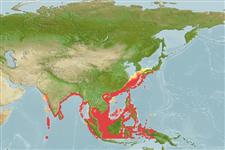Common names from other countries
>
Scombriformes (Mackerels) >
Scombridae (Mackerels, tunas, bonitos) > Scombrinae
Etymology: Scomberomorus: Latin, scomber = mackerel + Greek, moros = silly, stupid (Ref. 45335).
Environment: milieu / climate zone / depth range / distribution range
Ecologie
marien; oceanodroom (Ref. 51243). Tropical; 39°N - 6°S, 70°E - 138°E (Ref. 168)
Indo-West Pacific: west coast of India and Sri Lanka along the continental shelf eastward to Sumatra, Indonesia and Singapore, and northward to China, Korea (Ref. 9684) and Wakasa Bay, Sea of Japan. Does not extend past Sumatra in the East Indies (Ref. 9684).
Lengte bij maturiteit / Grootte / Gewicht / Leeftijd
Maturity: Lm ?, range 75 - ? cm
Max length : 150 cm FL mannelijk / geslacht onbekend; (Ref. 168); common length : 60.0 cm FL mannelijk / geslacht onbekend; (Ref. 168); max. gepubliceerd gewicht: 15.0 kg (Ref. 168)
Dorsale stekels (totaal) : 14 - 17; Dorsale zachte stralen (totaal) : 20 - 24; Anale stekels: 0; Anale zachte stralen: 20 - 24; Wervels: 46 - 47. Interpelvic process small and bifid. Lateral line with many auxiliary branches extending dorsally and ventrally in anterior third, gradually curving down toward caudal peduncle. Intestine with 4 folds and 5 limbs. Swim bladder absent. Body covered with small scales. Sides silvery with spots scattered along lateral median line.
Feeds on small schooling fishes, such as sardines and anchovies and on shrimps. This species makes up an important part of the drift net fishery in Palk Bay and the Gulf of Mannar. Marketed fresh and dried-salted (Ref. 9684).
Levenscyclus en paargedrag
Maturities | Voortplanting | Spawnings | Egg(s) | Fecundities | Larven
Collette, B.B. and C.E. Nauen, 1983. FAO Species Catalogue. Vol. 2. Scombrids of the world. An annotated and illustrated catalogue of tunas, mackerels, bonitos and related species known to date. Rome: FAO. FAO Fish. Synop. 125(2):137 p. (Ref. 168)
Status op de Rode Lijst van het IUCN (Ref. 130435)
CITES (Ref. 128078)
Not Evaluated
Gevaar voor de mens
Harmless
Gebruik door de mens
Visserij: van minder commercieel belang; sportvis: ja
Tools
Speciale rapporten
Download XML
Internetbronnen
Estimates based on models
Preferred temperature (Ref.
115969): 20.1 - 28.6, mean 27.3 (based on 823 cells).
Fylogenetische diversiteitsindex (Ref.
82804): PD
50 = 0.5000 [Uniqueness, from 0.5 = low to 2.0 = high].
Bayesian length-weight: a=0.00832 (0.00383 - 0.01808), b=3.03 (2.86 - 3.20), in cm Total Length, based on LWR estimates for this Genus-body shape (Ref.
93245).
Trofisch niveau (Ref.
69278): 4.2 ±0.74 se; based on food items.
Weerstandsvermogen (Ref.
120179): Gemiddeld, minimale populatieverdubbelingstijd 1,4-4,4 jaar (Preliminary K or Fecundity.).
Fishing Vulnerability (Ref.
59153): Very high vulnerability (90 of 100).
